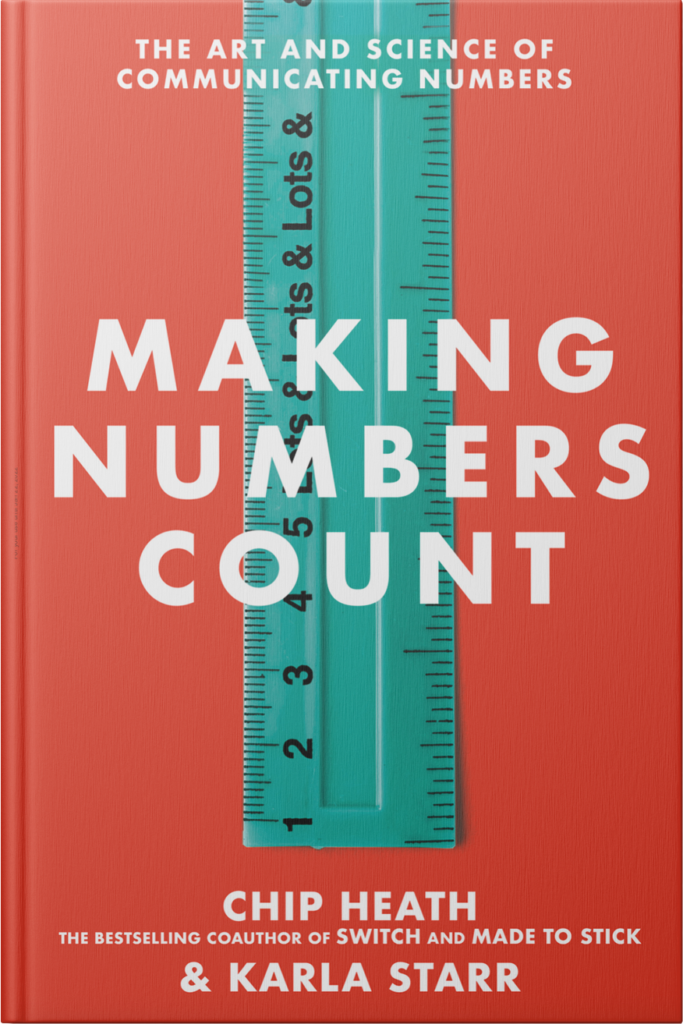BOOK REVIEW: Making Numbers Count: The Art and Science of Communicating Numbers
Authors: Chip Heath and Karla Starr
Book review by Melissa Braaten
According to COABE’s Educate and Elevate campaign, the U.S. has about 75 million adults considered “low-skilled” in numeracy. 75 million is a large number. But how large? How are we supposed to feel about this statistic? How can we wrap our minds around what it means for our own state, city, or program? We might consider that 75 million is almost twice the population of California. We might consider that 75 million is more than a quarter of the entire adult population of the U.S. We might consider that 75 million is about twice the number of adult Americans who have diabetes.
This was my attempt to produce a “translation,” a way of taking a number or statistic and communicating it in a way to make it more intuitive, understandable, and emotionally relevant to its audience. A new book by bestselling authors Chip Heath and Karla Starr called Making Numbers Count: The Art and Science of Communicating Numbers is all about various strategies for producing these translations. The book is written for the public: the authors specifically point out that this is a book for people who consider themselves “number people” and for people who don’t. After all, they argue, we all share brains that work in similar ways when it comes to numbers. Although some people might feel more comfortable working with numbers in their abstract, symbolic form, we all understand numbers most intuitively through the concrete experiences we can relate to, and through contexts we are already familiar with. By leveraging the types of numbers and measurements we already see, touch, and live out every day, we can bring important insights about numbers outside our daily experience into focus.

This explanation appealed to me, as it felt very much in tune with our philosophy of math education at the SABES Mathematics and Adult Numeracy Curriculum & Instruction PD Center. In our curriculum design and professional development, we emphasize conceptual understanding of mathematical topics, which begins with concrete experiences that students can see or touch, then creating representational ways of understanding the concept, before finally landing at a purely symbolic form.
As a content teacher (science and social studies), this book gave me a lot to think about as well. I love to include data in my content classes. After reading through the translation examples in the book, I realized I could make the data numbers much more meaningful and memorable for my students if I took some time to plan how I was going to communicate those numbers. I am always looking for ways to teach that work with our brains instead of against them!
Creating Number Translations

In other words, “It’s rude to make people feel they’re being excluded from the conversation.” Heath and Starr begin a chapter with this Japanese quote without providing a translation to make the point that no one likes being presented with things they don’t understand. In the same way, “Numbers are only fun if they make sense to everyone” (p. 5).
The authors start with some basics. Round your numbers to make them user friendly (6 million is better than 5.78 million), offer comparisons to amounts that are more familiar (Ireland is half the size of New York State), and consider scaling ratios up or down so they are at a scale that is easy to understand (for example, the US debt of $27 trillion dollars equates to $82,000 per citizen). Anything that brings numbers into the realm of the concrete, or resizes them to a human scale, will help them be more understandable and memorable.
Sometimes you can communicate your point without using numbers at all. The book offers an example of data from a test study of racial discrimination in hiring that showed that among equally qualified applicants,
34% of white applicants and 14% of black applicants without criminal records got callbacks, compared to 17% and 5% with records.
Their translation of those numbers eliminates the percentages altogether to make an impactful comparison:
White job applicants who had served jail time for a felony were more likely to receive a callback than were black applicants with impeccable records (p. 10).
Another section of the book discusses using “transferred emotion.” There are a lot of numbers that deserve an emotional reaction, but the way our brains are wired, larger numbers can lead to a type of numbing. The right translation can provide perspective that helps the audience not only understand the number, but also to provide some emotional context. Heath and Starr explore the example of Florence Nightingale, who used powerful “number translations” to help persuade British about the tragedy of soldiers dying in hospitals during the Crimean war. She knew that many of these deaths were due to a lack of hygiene and could be prevented. As she argued her case, she tapped into numbers that already had both an experiential and emotional relevance to her listeners. She reminded her listeners of the tragedy of the Birkenhead, a ship that sank with 400 men on board, an event that her listeners would already have had an emotional relationship to. Then she explained that in the military hospitals, they were losing more than 1,100 lives a year to preventable causes! In this case, Nightingale’s “translation” allowed her listeners to transfer the emotion they already felt about the Birkenhead to the tragedy she was laying before them – but this was one they could do something about.
I remember a similar translation in the early days of the COVID pandemic that stuck with me. At one point, the US was averaging 2,000 – 3,000 deaths per day from the pandemic. At the time, that was hard to wrap your mind around, especially if you lived in a part of the country where you didn’t know anyone personally affected. Then I heard it described this way: the death rate from COVID is roughly one September 11 attack every day. That made it sink in for me. September 11 was an event with already existing “pools of emotion,” which helped me to understand the scope of the tragedy unfolding across the country (and the world).
A later section in the book discusses ideas for bringing your numbers into the room through a visual or experiential demonstration. This chapter offers the example of Grace Hopper, an early computer programmer who was trying to help her students understand the importance of efficiency at the scale of microseconds. Microseconds are hard for humans to understand; they don’t exist at a “human scale.” To make it more concrete, Hopper brought 984 feet of copper wire into the room: the distance that a signal can travel in one microsecond. Powerful and memorable.
Teachers already know how effective a visual/experiential demonstration can be. Here is one I am thinking about using in my upcoming science unit about the digestive system. I could just give students the facts about how long each part of the system is: mouth and esophagus, 1 foot; stomach, .5 foot; small intestine, 15 feet; large intestine, 4 feet. Just numbers. Or, I could have students tie together different colors of yarn to create a long rope the length of the entire system, like this great activity here . The total rope of around 20 feet would be longer than our classroom!
A challenge for readers
What do you want your students to understand and care about? Choose one number relevant to that idea, and see what you can do to make the number come alive. For more ideas, take a stroll through Making Numbers Count. I guarantee you will encounter some memorable examples!

Melissa Braaten is an adult education instructor at Catholic Charities Haitian Multi-Services Center in Dorchester, MA. Melissa has taught ASE and pre-ASE math and reading, as well as ABE writing, computer skills, and health classes. Melissa also is a training and curriculum development specialist for the SABES Mathematics and Adult Numeracy Curriculum & Instruction PD Center at TERC. She has written several articles for Math Musings, the Adult Numeracy blog.
